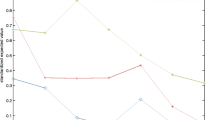Abstract
This paper presents an empirical analysis of public health expenditure on individuals in Denmark. The analysis separates out the individual effects of age and proximity to death (reflecting terminal costs of dying) and employs unique micro data from the period 2000 to 2009, covering a random sample of 10% of the Danish population. Health expenditure includes treatment in hospitals, subsidies to prescribed medication and health care provided by general practitioners and specialists and covers about 80% of public health care expenditure on individuals. The results confirm findings from previous studies showing that proximity to death has a significant impact on health care expenditure. However, it is also found that cohort effects (the baby boom generation) as well as improvements in life expectancy have a substantial effect on future health care expenditure even when proximity to death is controlled for. These results are obtained by combining the empirical estimates with a long term population forecast. When life expectancy increases, terminal costs are postponed but the increases in health expenditure that follow from longer life expectancy are not as large as the increase in the number of elderly persons would suggest (due to “healthy ageing”). Based on the empirical estimates, healthy ageing is expected to reduce the impact of increased life expectancy on real health expenditure by 50% compared to a situation without healthy ageing.
Similar content being viewed by others
References
Cameron A. C., Trivedi P. K. (2005) Microeconometrics—methods and applications. Cambridge University Press, New York
Cutler, D. M., & Meara, E. (1999). The concentration of medical spending: An update. NBER Working Paper No. 7279.
Cutler, D. M. & Sheiner, L. (1998). Demographics and medical care spending: Standard and non-standard effects. NBER Working Paper No. 6866.
Danish Economic Councils: (2009) Danish economy, autumn 2009. Danish Economic Councils, Denmark
DREAM. (2009). Langsigtet økonomisk fremskrivning 2009. DREAM.
Duan N. (1983) Smearing estimate: A nonparametric retransformation method. Journal of the American Statistical Association 78: 605–610
Felder S., Meiers M., Schmitt H. (2000) Health care expenditure in the last months of life. Journal of Health Economics 19(5): 652–695
Felder S., Werblow A., Zweifel P. (2010) Do red herrings swim in circles?. Journal of Health Economics 29(2): 205–212
Frank L. (2000) When an entire country is a cohort. Science 287(5462): 2398–2399
Getzen T. E. (1992) Population aging and the growth of health expenditures. Journal of Gerontology: Social Sciences 47: 98–104
Grossman, M. (2000). The human capital model. In A. J. Culyer & J. P. Newhouse (Eds.), Handbook of health economics (Vol. 1A). Handbooks in economics (Vol. 17, pp. 347–408). Amsterdam; New York: Elsevier; North-Holland.
Grossman M. (1972) On the concept of health capital and the demand for health. Journal of Political Economy 80(2): 223–255
Häkkinen U., Martikainen P., Noro A., Nihtilä E., Peltola M. (2008) Aging, health expenditure, proximity to death, and income in Finland. Health Economics, Policy and Law 3: 165–195
Hansen, M. F., & Barington, M. L. (2009). Danmarks fremtidige befolkning—Befolkningsfremskrivning 2009. DREAM.
Hansen M. F., Pedersen L. H. (2010) Sundhedsudgifter og finanspolitisk holdbarhed. Nationaløkonomisk Tidsskrift 148(1): 21–42
Hoover D. R., Crystal S., Kumar R., Sambomorthi U., Cantor J. C. (2002) Medical expenditures during the last year of life: Findings from the 1992–1996 medicare current beneficiary survey. Health Services Research 37(6): 1625–1642
Manning W. G., Mullahy J. (2001) Estimating log models: To transform or not to transform. Journal of Health Economics 20(4): 461–494
OECD. (2006). Projecting OECD Health and Long-term Care Expenditures: What are the main Drivers. Economics Department Working Papers, 477.
Salas C., Raftery J. P. (2001) Econometric issues in testing the age neutrality of health care expenditure. Health Economics 10: 669–671
Seshamani M., Gray A. (2004) A longitudinal study of the effects of age and time to death on hospital costs. Journal of Health Economics 23: 217–235
Seshamani M., Gray A. (2004) Ageing and health-care expenditure: The red herring argument revisited. Health Economics 13(4): 303–314
Werblow A., Felder S., Zweifel P. (2007) Population ageing and health care expenditure: A school of ‘red herrings’?. Health Economics 16(10): 1109–1126
Zweifel P., Felder S., Meiers M. (1999) Ageing of population and health care expenditure: A red herring?. Health Economics 8(6): 485–496
Zweifel P., Felder S., Werblow A. (2004) Population ageing and health care expenditure: New evidence on the red herring. The Geneva Papers on Risk and Insurance 29(4): 652–666
Author information
Authors and Affiliations
Corresponding author
Additional information
The authors are grateful for comments and suggestions from Lars Haagen Petersen, Niels Henning Bjørn, Jes Søgaard, the chairmen of the Danish Economic Councils and the anonymous referee. Mette Møller Jørgensen has given excellent research assistance. Finally, thanks to Marianne Frank Hansen from the DREAM research group for access to the Danish population forecast data. However, any errors and omissions are solely the responsibility of the authors.
Rights and permissions
About this article
Cite this article
Bjørner, T.B., Arnberg, S. Terminal costs, improved life expectancy and future public health expenditure. Int J Health Care Finance Econ 12, 129–143 (2012). https://doi.org/10.1007/s10754-012-9106-1
Received:
Accepted:
Published:
Issue Date:
DOI: https://doi.org/10.1007/s10754-012-9106-1




